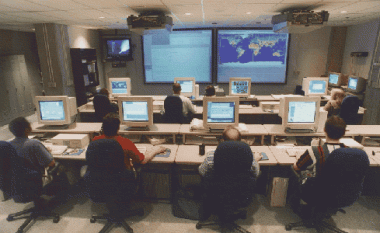
|
FUSE
|
Mission Status Report
|

Mission Status Report #15 Star Date: August 23, 1999
NOTE: Mission Status Reports on the web page will continue roughly once a week, as
events unfold.
-- Bill Blair

The Satellite Control Center at JHU.
(Click image to see larger version.)
Checkout Progress Slowed by Solar Activity
The last week has seen continued progress on FUSE checkout activities, but
at a slower pace, due to some difficulties both on the satellite and ground
support system. In particular, it appears that at least some of these problems may
have been triggered by high solar activity and an ensuing (but temporary)
change in the radiation environment of the satellite.
Certain electronic components in FUSE are sensitive to the influx of high
energy particles. One of these areas is the computer memory of the detectors
in the spectrographs. The control software is run in two redundant areas of memory
(let's call them "upper" and "lower" memory), so that if a particle event (called
a "single event upset", or SEU) is detected in (say) upper memory, we can switch
to lower memory, and vice versa, with no operational impact. The occurence of
SEUs is typically one per 5 days or so, and so the chances of getting an SEU in
both upper and lower memory in the same time period on the same detector is
very low. Well, you guessed it--it happened early last week, and furthermore,
it happened to the detector we had fully ramped up and were using for testing!
Analysis after the fact showed that the solar X-ray flux had increased by a
factor of 100, implicating high solar activity as the probable culprit.
Our protocol for this situation is to turn off the affected detector, turn it back
on, reload the memory areas again, and then continue. We also had to ramp the
high voltage back up to operating values, which takes a full day. We are now
back up and operating normally.
Another unexpected problem cropped up late in the week, when we lost functionality
in our primary ground station antenna at the University of Puerto Rico Mayaguez.
A fire at a power sub-station in Mayaguez terminated power to the antenna and
support equipment. The backup generator carried things for awhile, but when the
power was not restored in time, the site lost power entirely. When power was
restored, the system did not boot back up properly, possibly indicating a hardware
problem. (This is still being diagnosed.) Thus. continued operations have been
occurring through the commercial Hawaii station of Universal Spacenet.
Despite these difficulties, progress was made this week. We have taken numerous
"background" exposures with the detector and seen airglow lines (emission from the
residual atmosphere above FUSE). We have run tests that have shown the relative
pointing positions of the two separate telescope mirrors that use detector 1.
(This is basically a practice run for what will have to be done to get all four
mirrors aligned.) And we have performed a successful "gyro calibration" which should
help in smoothing out future target acquisitions.
We still expect to be able to ramp up the high voltage on detector 2 this week, depending
somewhat on the situation at the Puerto Rico ground station. With both detectors
ramped up, we can then begin the process of alignment and focus of all four telescopes!
It is important to note that, while many problems have been encountered during
checkout,, they are of the annoying "slow-you-down" kind. The satellite is
healthy, and the hardware is working! It just takes time.
Reported by: Bill Blair, Chief of Mission Planning

|